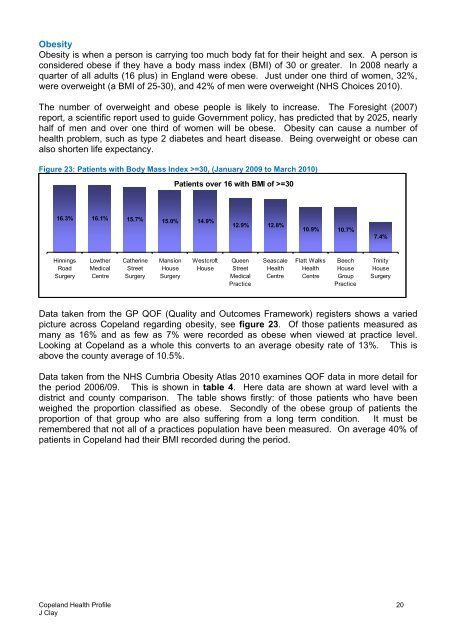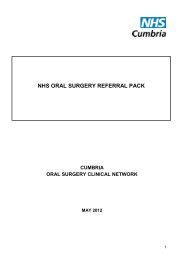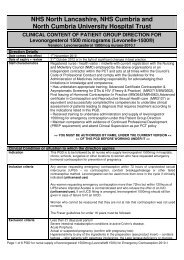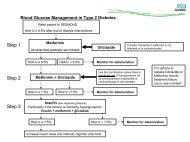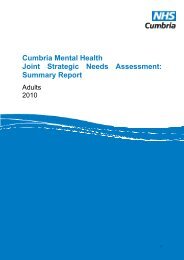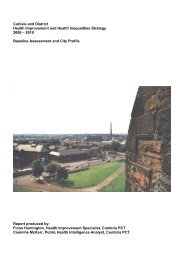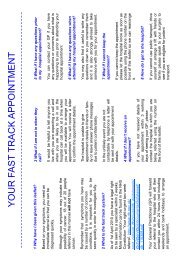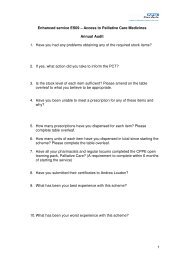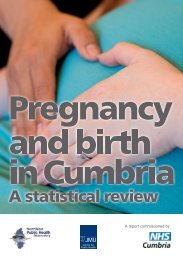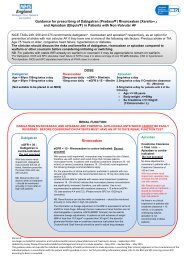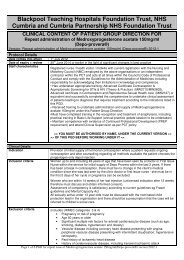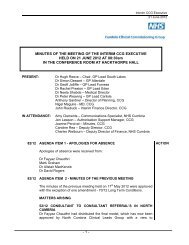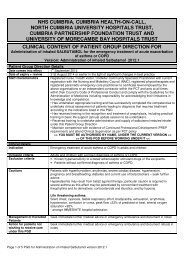Copeland Health Profile 2010 - Cumbria County Council
Copeland Health Profile 2010 - Cumbria County Council
Copeland Health Profile 2010 - Cumbria County Council
You also want an ePaper? Increase the reach of your titles
YUMPU automatically turns print PDFs into web optimized ePapers that Google loves.
Obesity<br />
Obesity is when a person is carrying too much body fat for their height and sex. A person is<br />
considered obese if they have a body mass index (BMI) of 30 or greater. In 2008 nearly a<br />
quarter of all adults (16 plus) in England were obese. Just under one third of women, 32%,<br />
were overweight (a BMI of 25-30), and 42% of men were overweight (NHS Choices <strong>2010</strong>).<br />
The number of overweight and obese people is likely to increase. The Foresight (2007)<br />
report, a scientific report used to guide Government policy, has predicted that by 2025, nearly<br />
half of men and over one third of women will be obese. Obesity can cause a number of<br />
health problem, such as type 2 diabetes and heart disease. Being overweight or obese can<br />
also shorten life expectancy.<br />
Figure 23: Patients with Body Mass Index >=30, (January 2009 to March <strong>2010</strong>)<br />
Patients over 16 with BMI of >=30<br />
16.3% 16.1% 15.7% 15.0% 14.9%<br />
12.9% 12.8%<br />
10.9% 10.7%<br />
7.4%<br />
Hinnings<br />
Road<br />
Surgery<br />
Lowther<br />
Medical<br />
Centre<br />
Catherine<br />
Street<br />
Surgery<br />
Mansion<br />
House<br />
Surgery<br />
Westcroft<br />
House<br />
Queen<br />
Street<br />
Medical<br />
Practice<br />
Seascale<br />
<strong>Health</strong><br />
Centre<br />
Flatt Walks<br />
<strong>Health</strong><br />
Centre<br />
Beech<br />
House<br />
Group<br />
Practice<br />
Trinity<br />
House<br />
Surgery<br />
Data taken from the GP QOF (Quality and Outcomes Framework) registers shows a varied<br />
picture across <strong>Copeland</strong> regarding obesity, see figure 23. Of those patients measured as<br />
many as 16% and as few as 7% were recorded as obese when viewed at practice level.<br />
Looking at <strong>Copeland</strong> as a whole this converts to an average obesity rate of 13%. This is<br />
above the county average of 10.5%.<br />
Data taken from the NHS <strong>Cumbria</strong> Obesity Atlas <strong>2010</strong> examines QOF data in more detail for<br />
the period 2006/09. This is shown in table 4. Here data are shown at ward level with a<br />
district and county comparison. The table shows firstly: of those patients who have been<br />
weighed the proportion classified as obese. Secondly of the obese group of patients the<br />
proportion of that group who are also suffering from a long term condition. It must be<br />
remembered that not all of a practices population have been measured. On average 40% of<br />
patients in <strong>Copeland</strong> had their BMI recorded during the period.<br />
<strong>Copeland</strong> <strong>Health</strong> <strong>Profile</strong><br />
J Clay<br />
20


